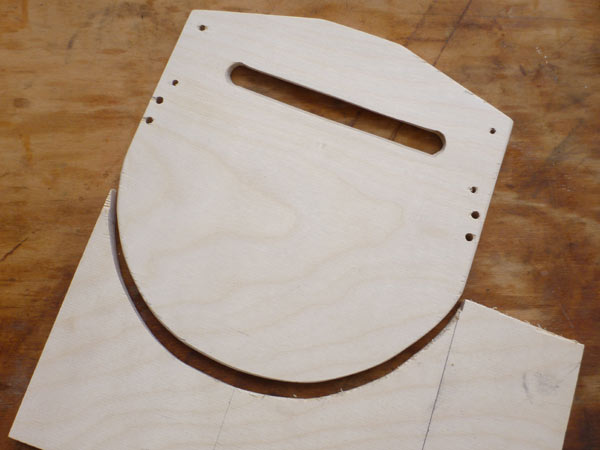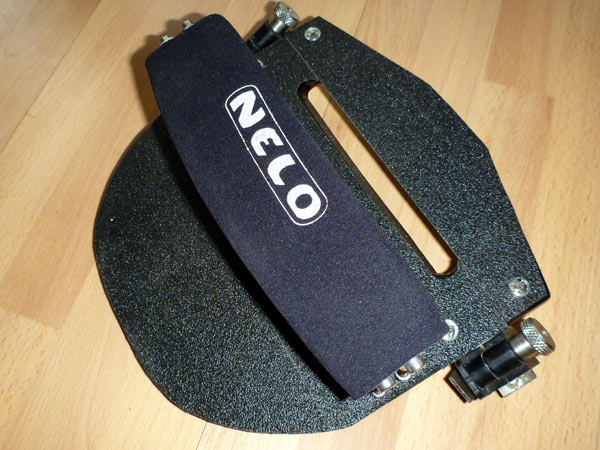DIY Footboard Upgrade
Posted by Greg on February 1, 2012My latest DIY project was to create a full footboard to replace the skimpy original on my K1 (right).
This was a relatively quick and inexpensive project. First task was to make a cardboard pattern to determine the size and fit. For the construction I used 1/2″ (12.7mm) thick birch plywood, but it’s stronger than it needs to be, 3/8″ (9.5mm) thickness would be fine, and would save a little weight.
The only challenging part of the operation was to cut the slot for the tiller bar (rudder control) as this needs to be cut at the same angle as the slope of the footboard or the tiller will stick. My approach was to drill two holes at each end of the slot using an old-fashioned bit-brace (hand drill) with a bit the same diameter as the intended slot. To get the angle right, I placed a sliding T bevel set at 60 degrees on the stock and just eyeballed it as I drilled. A sabre saw with an adjustable base (set to 60 degrees) made quick work of cutting the waste from the slot.
Why a 60 degree angle? Both my SpeedStroke erg (indoor kayak trainer) and Epic V12 ski have 60 degree footboards and they’re very comfortable. I chose the same angle for training consistency, when moving from erg to boat to boat. Obviously a vertical plate is not ergonomic (a lthough vertical bulkheads are sometimes used as a footrest by sea kayakers). Angles of 45 degrees or less may result in your feet sliding up the footboard under pressure. In the end it’s up to your personal preference.
lthough vertical bulkheads are sometimes used as a footrest by sea kayakers). Angles of 45 degrees or less may result in your feet sliding up the footboard under pressure. In the end it’s up to your personal preference.
To improve traction, I originally covered the footboard with non-slip tape (intended for stairs) found at most hardware stores. It works but looks and feels like sandpaper and can be too abrasive against wet, bare feet. The image above shows the footboard covered with this material. I replaced it with Hydro-turf traction pad strips — grippy, firm, and comfortable — a big improvement.
Now to finally replace that ratty foot-strap. After looking at various pull-bars I decided on the Nelo Carbon Pull-bar. It’s light, ergonomic and highly adjustable (depth and angle). It arrived in less than a week from Portugal.
The original footrest wasn’t horrible, at least it had a much larger surface area than the tiny Yakima-style pegs that most sea kayakers put-up with, and the plate allowed micro-adjustments to the angle for comfort. I prefer to push with my stroke side heel, rather than the balls of my feet, so I find a full footboard to be not only more comfortable but permits a more efficient stroke as well.
[Warning – vaguely related rant commencing]
What is amazing to me is that racing kayaks have, by far, the best ergonomics, even though some races are finished in less than two minutes! Sea kayaks generally have poor ergonomics even though sea kayakers are often in their boats for many hours. The longest that I have been in a kayak was 22 grueling hours during a crossing in Iceland when the weather didn’t cooperate. Change will have to come through sea kayakers demanding better ergonomics. Ironically, the original skin-on-frame kayaks usually offer very good foot support, with a deck beam that gives full-width support for the balls of your feet, and a rib placement just forward of your heel to provide a comfortable angle.
[Sermon over. OK, I feel better now…]
So how did the footboard upgrade work? I’m happy to report that it transformed my entire sense of security and control in the K1. Although I still have the occasional misstep and resulting brace, the K1 has been largely tamed, and I can now paddle it aggressively, instead of defensively. The pull bar makes a huge difference. It gives you something solid to help control the kayak, to aid balance, and enables some sense of being a part of the kayak (rather than just loosely sitting on top of it). I’m guessing that with time and practice it won’t be as necessary. It’s probably just like rolling when at first you need a very snug, secure fit, in order to transmit your meager attempts to the kayak, and later on you can roll almost anything so long as you don’t fall out of it first. As a safety note, with any gear that you add to your kayak, ensure that it doesn’t affect your ability to exit the kayak in case of a capsize.
A drawback of the pull bar is that it restricts lateral movement with your feet, so the tiller (rudder) can only accept small corrections. More than once I have found myself heading straight toward a buoy or hazard, with the tiller hard over, shouting , “Turn Dammit, Turn!”, imploring the kayak to turn. Eventually the kayak listens and responds but not with any haste. This K1 has a tiny rudder, designed for minute course corrections (and low drag), and response is much more sluggish as compared to the rudder on my V12 surfski. For a more rapid turn you can lean the kayak and pull a foot out of the pull-strap to give the tiller more room to move, but I’d rather keep my feet in the pull-bar, if possible.
Technique
Not surprisingly there are some strong differences of opinion on using a pull-bar or foot-strap. Some coaches teach that you use the pull-bar to actively push with one leg and pull-up on the bar with the other. Other coaches state that this is counterproductive and that you push strongly with the heel of the stroke-side foot, and the pull-bar simply provides support to aid balance as your non-stroke-side knee rises and the non-stroke-side foot lifts upward into the bar, helping to smooth out any wobbles. I will explore this more in-depth in the future, along with some ideas from Hungarian coach Imre Kemecsey.
Here’s another blog post on pull-pars that you might find informative.



Making your very own customized footboard isn’t an easy feat, kudos to you Greg! How is the movement of your kayak now after having installed your DIY upgrade for almost a month?
Stability in the K1 continues to improve but it was adding the full footplate with a solid pull-bar that made all the difference. It’s really night and day! I have been paddling my V12 surfski more than the K1 lately, but I am enjoying the K1 more and more. The K1 at full flight feels like skiing bumps in that it is requires a very precise choreography — almost like a dance. You can feel every nuance of how body movement and the paddle effects boat movement which is great for refining technique. I still get tired quicker in the K1 than the ski, since you can never completely relax and all the stabilizer muscles are constantly firing, but I imagine this will improve over time. For backwater paddling I prefer the ski, since alligators are very common in central Florida, and I prefer to have a fast way to remount, rather than swim to shore through muck, weeds and large reptiles.
how did you fasten the nelo pull bar to the wood?
Bill,
The Nelo carbon pull bar attaches with four long machine screws. These are fully threaded to enable you to adjust the height and angle. In the blog post there’s an image of the unpainted wood foot-board. The mounting holes for the pull bar are the bottom four holes. These screws are intended to fit into a metal frame, but attaching to the foot-board works fine in this case (fit will depend on the size of your foot-board).
I recently acquired an Epic Legacy and much prefer the Nelo carbon pull bar to the stock strap that comes on the Epic.
i bought a carbon pull bar from Nelo but it has four short machine screws that come out of the pull bar laterally. so i have to figure out a way to mount it. i wish mine had come like yours. i wonder if Nelo has changed the pull bar, or if i ordered the wrong one.
Any thoughts on converting surfski gas pedals to foot plate and tiller bar? Thx.
Interesting question. Tiller bar installation needs accessible space about a foot forward of the footplate, so I don’t think it would be practical for most surf skis due to the closed hull. It works for a K1 because of the long open cockpit and access to the hull forward of the footplate. That said, perhaps the tiller could be mounted “backwards” with the pivot in the cockpit and the tiller bar facing toward the bow but it might be a hazard in a spill and for reentry.
I find tiller steering good for flatwater but I prefer the gas pedals for more lively conditions. Some buddies of mine who use tiller steering in high-performance sea kayaks report that it is tough to brace and steer at the same and that you must always keep your feet in the center of the footplate (more of an issue with a wider sea kayak than in a ski).
And any thoughts of converting ruddered sea kayaks to foot plate and tiller bar?
I have a valley skeged one to which I added a foot plate resting on the small foot pegs coming with the kayak. It works giving me the posibility to move my feet around on the long hours on the water.
I come from a background on K1s and I always wondered why sea kayaks don’t have the tiller to steer. if it is because how much you can pull the cable it can be fixed with a a longer or wider T.
It is still a project I have in mind for the day I buy a ruddered sea kayak.